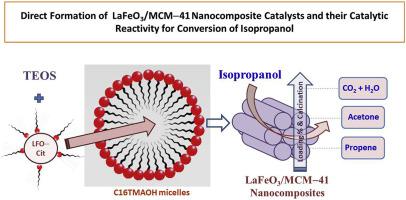当前位置:
X-MOL 学术
›
Mater. Chem. Phys.
›
论文详情
Our official English website, www.x-mol.net, welcomes your
feedback! (Note: you will need to create a separate account there.)
Direct formation of LaFeO3/MCM−41 nanocomposite catalysts and their catalytic reactivity for conversion of isopropanol
Materials Chemistry and Physics ( IF 4.3 ) Pub Date : 2020-11-01 , DOI: 10.1016/j.matchemphys.2020.123412 Kamal M.S. Khalil , Walaa A. Elhamdy , Abd-El-Aziz A. Said
Materials Chemistry and Physics ( IF 4.3 ) Pub Date : 2020-11-01 , DOI: 10.1016/j.matchemphys.2020.123412 Kamal M.S. Khalil , Walaa A. Elhamdy , Abd-El-Aziz A. Said

|
Abstract Direct formation of 3–30% (w/w) LaFeO3/MCM−41, nanocomposite catalysts were performed by a sol−gel process, followed by calcination at 550 and 750 °C. The nanocomposites were characterized through different techniques including LAXRD, WAXRD, EDX, simultaneous TG−DTA, ATR−FTIR, nitrogen adsorption/desorption, and TEM. The nanocomposites featured high surface areas (up to 1000 m2/g) and enhanced thermal stability. The direct formation method led to nanodispersion and size confinement of LaFeO3 in MCM−41 mesopores. The nanocomposites showed very high catalytic activity for isopropanol conversion, whereas their parent materials (blank MCM-41 or bulk LaFeO3) were totally inactive under the same reaction conditions. Thus, nanocomposite catalysts with low loading ratios and low calcination temperature produced pure dehydration product (propene) with very high conversion and total selectivity. Nanocomposite catalysts with high loading ratios and high calcination temperature produced an appreciable amount of the dehydrogenation product (acetone) as well as the dehydration products. Moreover, high loading ratios at high reaction temperatures in air atmosphere led to the formation of oxidation products. The different reactivities of the nanocomposite catalysts were discussed and correlated to their nanostructure, in terms of enhancing of the mesoporous textures with surface acidity, oxidation ability and thermal stability.
中文翻译:

LaFeO3/MCM−41纳米复合催化剂的直接形成及其对异丙醇转化的催化反应性
摘要 通过溶胶-凝胶工艺直接形成 3-30% (w/w) LaFeO3/MCM-41 纳米复合催化剂,然后在 550 和 750 °C 下煅烧。通过不同的技术对纳米复合材料进行表征,包括 LAXRD、WAXRD、EDX、同时 TG-DTA、ATR-FTIR、氮吸附/解吸和 TEM。纳米复合材料具有高表面积(高达 1000 平方米/克)和增强的热稳定性。直接形成方法导致 LaFeO3 在 MCM-41 介孔中的纳米分散和尺寸限制。纳米复合材料对异丙醇转化显示出非常高的催化活性,而它们的母体材料(空白 MCM-41 或块状 LaFeO3)在相同的反应条件下完全没有活性。因此,具有低负载率和低煅烧温度的纳米复合催化剂产生了具有非常高转化率和总选择性的纯脱水产物(丙烯)。具有高负载率和高煅烧温度的纳米复合催化剂产生了大量的脱氢产物(丙酮)以及脱水产物。此外,空气气氛中高反应温度下的高负载率导致氧化产物的形成。讨论了纳米复合催化剂的不同反应性,并将其与纳米结构相关联,在增强具有表面酸性、氧化能力和热稳定性的介孔结构方面。具有高负载率和高煅烧温度的纳米复合催化剂产生了大量的脱氢产物(丙酮)以及脱水产物。此外,空气气氛中高反应温度下的高负载率导致氧化产物的形成。讨论了纳米复合催化剂的不同反应性,并将其与纳米结构相关联,在增强具有表面酸性、氧化能力和热稳定性的介孔结构方面。具有高负载率和高煅烧温度的纳米复合催化剂产生了大量的脱氢产物(丙酮)以及脱水产物。此外,空气气氛中高反应温度下的高负载率导致氧化产物的形成。讨论了纳米复合催化剂的不同反应性,并将其与纳米结构相关联,在增强具有表面酸性、氧化能力和热稳定性的介孔结构方面。
更新日期:2020-11-01
中文翻译:

LaFeO3/MCM−41纳米复合催化剂的直接形成及其对异丙醇转化的催化反应性
摘要 通过溶胶-凝胶工艺直接形成 3-30% (w/w) LaFeO3/MCM-41 纳米复合催化剂,然后在 550 和 750 °C 下煅烧。通过不同的技术对纳米复合材料进行表征,包括 LAXRD、WAXRD、EDX、同时 TG-DTA、ATR-FTIR、氮吸附/解吸和 TEM。纳米复合材料具有高表面积(高达 1000 平方米/克)和增强的热稳定性。直接形成方法导致 LaFeO3 在 MCM-41 介孔中的纳米分散和尺寸限制。纳米复合材料对异丙醇转化显示出非常高的催化活性,而它们的母体材料(空白 MCM-41 或块状 LaFeO3)在相同的反应条件下完全没有活性。因此,具有低负载率和低煅烧温度的纳米复合催化剂产生了具有非常高转化率和总选择性的纯脱水产物(丙烯)。具有高负载率和高煅烧温度的纳米复合催化剂产生了大量的脱氢产物(丙酮)以及脱水产物。此外,空气气氛中高反应温度下的高负载率导致氧化产物的形成。讨论了纳米复合催化剂的不同反应性,并将其与纳米结构相关联,在增强具有表面酸性、氧化能力和热稳定性的介孔结构方面。具有高负载率和高煅烧温度的纳米复合催化剂产生了大量的脱氢产物(丙酮)以及脱水产物。此外,空气气氛中高反应温度下的高负载率导致氧化产物的形成。讨论了纳米复合催化剂的不同反应性,并将其与纳米结构相关联,在增强具有表面酸性、氧化能力和热稳定性的介孔结构方面。具有高负载率和高煅烧温度的纳米复合催化剂产生了大量的脱氢产物(丙酮)以及脱水产物。此外,空气气氛中高反应温度下的高负载率导致氧化产物的形成。讨论了纳米复合催化剂的不同反应性,并将其与纳米结构相关联,在增强具有表面酸性、氧化能力和热稳定性的介孔结构方面。











































 京公网安备 11010802027423号
京公网安备 11010802027423号